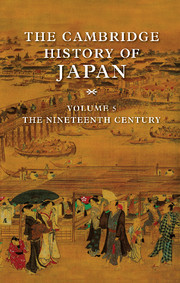Book contents
- Frontmatter
- Introduction
- 1 Japan in the early nineteenth century
- 2 The Tempō crisis
- 3 Late Tokugawa culture and thought
- 4 The foreign threat and the opening of the ports
- 5 The Meiji Restoration
- 6 Opposition movements in early Meiji, 1868–1885
- 7 Japan's turn to the west
- 8 Social change
- 9 Economic change in the nineteenth century
- 10 Meiji political institutions
- 11 Meiji conservatism
- 12 Japan's drive to great-power status
- Works Cited
- Index
- References
1 - Japan in the early nineteenth century
Published online by Cambridge University Press: 28 March 2008
- Frontmatter
- Introduction
- 1 Japan in the early nineteenth century
- 2 The Tempō crisis
- 3 Late Tokugawa culture and thought
- 4 The foreign threat and the opening of the ports
- 5 The Meiji Restoration
- 6 Opposition movements in early Meiji, 1868–1885
- 7 Japan's turn to the west
- 8 Social change
- 9 Economic change in the nineteenth century
- 10 Meiji political institutions
- 11 Meiji conservatism
- 12 Japan's drive to great-power status
- Works Cited
- Index
- References
Summary
The first third of the nineteenth century in Japan was dominated by personalities and policies that appeared on the scene in the last decade of the eighteenth century. The reform measures of Matsudaira Sadanobu and the personal preferences of his shogun, Tokugawa Ienari, lent a considerable continuity to the Bunka (1804–18) and Bunsei (1818–30) eras.
In contrast with the devastation and famine that the crop failures of the 1780s had brought, the quarter-century that followed seemed something of an Indian summer of Tokugawa rule. The years were marked by good harvests. The long continuity of Ienari, whose half-century in office marked the longest tenure of any of the fifteen Tokugawa shoguns, was reflected in a lack of political surprises in bakufu or daimyo domains. Economic growth, both in agriculture and in the provision of materials for the great metropolis of Edo, a striking rise in the diffusion of schooling, and the impressive production of material for the growing reading public all contributed to the impression of well-being. Arbitrary status divisions laid down by the seventeenth-century founders had less relevance in a period of economic change and growth. At the top of the samurai ranks, hereditary income and privilege stood as a guarantee of continuity, but the great urban merchants lived as well as did the petty daimyo, and the lower ranks of the samurai military were considerably worse off than were the middling merchants and artisans. In the countryside a clear division between the landholding village leaders and the landless and tenants was making a mockery of the regime's “peasant” ideal.
- Type
- Chapter
- Information
- The Cambridge History of Japan , pp. 50 - 115Publisher: Cambridge University PressPrint publication year: 1989
References
- 9
- Cited by

